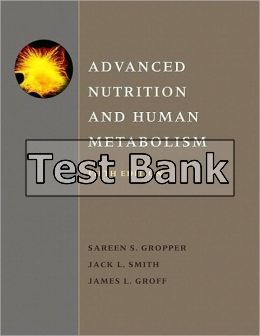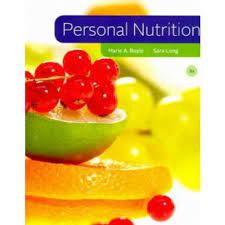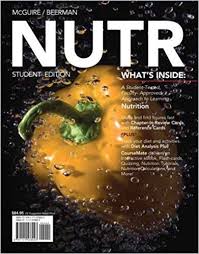Description
Test Bank For Advanced Nutrition and Human Metabolism 5th Edition by Sareen S. Gropper
Chapter 2 – The Digestive System: Mechanism for Nourishing the Body
Multiple-Choice
Key Page(s)
b 34 1. Within the lamina propria, lying just below the epithelium, is the mucosa-associated lymphoid tissue which
a. controls secretions from the mucosal glands.
b. contains white blood cells and protects against ingested microorganisms.
c. initiates peristalsis.
d. secretes mucus, hormones and digestive juices into the lumen.
d 37-38 2. The volume of a normal stomach ranges from 50 mL (~2 oz) when empty to _____ when full.
a. 100 mL (~4 oz)
b. 250 mL (~1 cup)
c. 750 mL (~3 cups)
d. 1.5 L (~ 6 cups)
c 47 3. The pancreas is a digestive system accessory organ with two types of active tissue, the ductless endocrine tissue that secretes insulin and glucagon and the
a. liver-like tissue that produces bile.
b. ductless absorptive tissue that controls bicarbonate.
c. ducted exocrine tissue that produces digestive enzymes.
d. ducted erythropoietic tissue that produces red blood cells.
b 47 4. Pancreatic juice that enters the duodenum through the sphincter of Oddi contains all of the following EXCEPT _____.
a. digestive enzymes
b. intrinsic factor
c. anions such as bicarbonate and chloride
d. cations such as sodium, potassium and calcium
c 45 5. Most of the digestive enzymes produced by the intestinal mucosal cells function
a. in the stomach.
b. in the intestinal lumen.
c. at the brush border.
d. within the cytoplasm of the enterocytes.
a 56 6. Among the regulatory peptide molecules, some are recognized as true hormones. Which of the following is a paracrine rather than a hormone?
a. somatostatin
b. secretin
c. cholecystokinin
d. gastrin
b 57 7. The major role of gastrin in the GI tract is that of _____.
a. inhibition
b. stimulation
c. transport
d. no effect
d 57 8. Which regulatory peptide synthesized in the pancreatic and intestinal cells appears to inhibit release of gastrin, secretin, and motilin?
a. neurotensin
b. GRP
c. insulin
d. somatastatin
c 34, 56 9. Which structural component of the gastrointestinal tract is within the muscularis externa and controls the contractions that cause motility?
a. muscularis mucosae
b. submucosal plexus
c. myenteric plexus
d. lumen
c 35-36 10. What is the name of the digestive enzyme in saliva that digests starch?
a. lipase
b. synthetase
c. amylase
d. lactase
d 38 11. What product produced by neck cells in the oxyntic gland of the stomach protects the epithelium from mechanical and chemical damage?
a. amylase
b. pepsin
c. gastrin
d. mucus
b 38 12. What cells, found both in oxyntic glands and pyloric glands of the stomach, secrete hydrochloric acid and intrinsic factor?
a. neck cells
b. parietal cells
c. chief cells
d. enteroendocrine cells
c 38 13. What cells, found in oxyntic glands in the body of the stomach secrete pepsinogens?
a. neck cells
b. parietal cells
c. chief cells
d. enteroendocrine cells
d 40 14. A function of hydrochloric acid in the gastric juice is to
a. digest protein, functioning as an endopeptidase.
b. protect the stomach lining from damage.
c. inhibit secretion of gastrin and CCK.
d. act as a bactericide agent.
a 41, 49 15. Which of the following digestive fluids is the most alkaline?
a. bile
b. pancreatic juice
c. saliva
d. gastric juice
b 43 16. Approximately how much chyme per minute is allowed to enter the duodenum from the stomach?
a. 1 – 5 mL
b. 6 – 10 mL
c. 11 – 15 mL
d. 16 – 20 mL
d 34, 47 17. Which of the following is NOT considered an accessory organ?
a. pancreas
b. liver
c. gallbladder
d. spleen
c 47 18. In what organ are enzymes produced which are responsible for digestion of 50% of carbohydrate and protein and 90% of fat?
a. liver
b. esophagus
c. pancreas
d. gallbladder
b 47, 57 19. The hormone whose major action is to alkalize intestinal contents by stimulating secretion of bicarbonate from the pancreas and by inhibiting gastric acid secretion and gastric emptying is _____.
a. gastrin
b. secretin
c. cholecystokinin
d. GRP
c 50, 57 20. The hormone primarily responsible for contraction of the gallbladder and release of bile into the duodenum is _____.
a. gastrin
b. secretin
c. cholecystokinin
d. GRP
c 49 21. Bile salts are synthesized from cholesterol in the _____.
a. canaliculi
b. common bile duct
c. hepatocytes
d. gallbladder
a 49 22. Conjugation of bile acids with glycine and taurine improves their ability to
a. ionize and form micelles.
b. undergo enterohepatic recirculation.
c. be excreted in the feces, thus keeping serum cholesterol normal.
d. promote the formation of bile salts.
d 50 23. The total bile acid pool in the human body is 2.5 to 5 g. What percent of bile is reabsorbed in the ileum?
a. 10%
b. 30%
c. 65%
d. 90%
c 50 24. Bile is most important for the digestion and absorption of _____.
a. carbohydrates
b. proteins
c. fats
d. vitamins
d 50 25. What percentage of cholesterol in bile is used to form chylomicrons?
a. none of it
b. 10%
c. 25%
d. 50%
c 51 26. In general, in which portion of the gastrointestinal tract does most absorption occur?
a. esophagus
b. stomach
c. small intestine
d. colon
b 51 27. How long does it take for most of the carbohydrate, protein and fat to be absorbed from chyme after it enters the small intestine?
a. 10 minutes
b. 30 minutes
c. 1 hour
d. 2 hours





Be the first to review “Test Bank For Advanced Nutrition and Human Metabolism 5th Edition by Sareen S. Gropper”